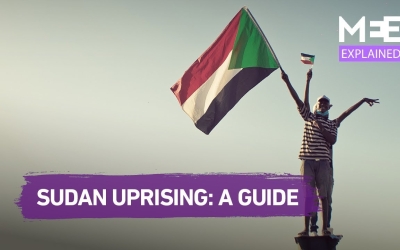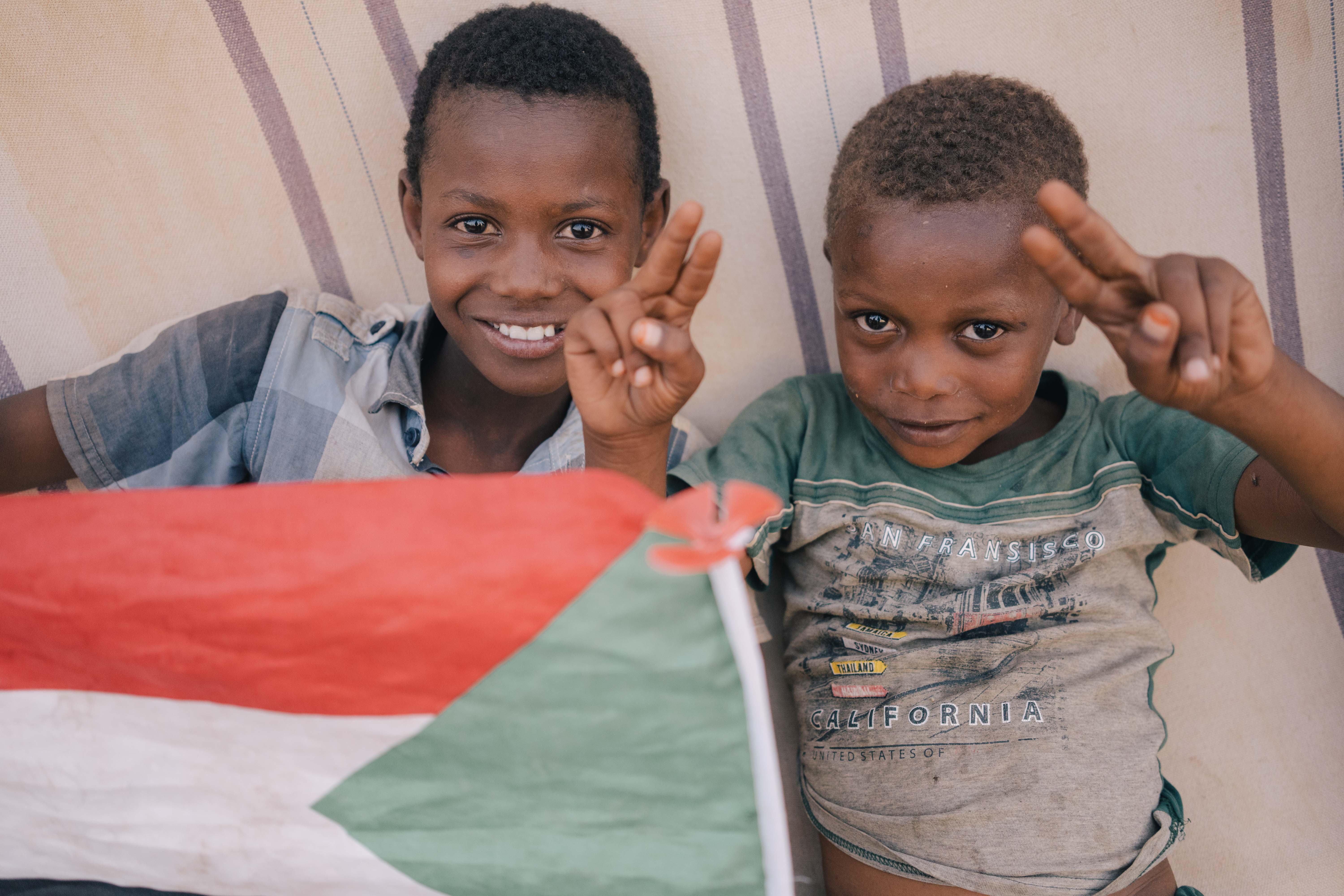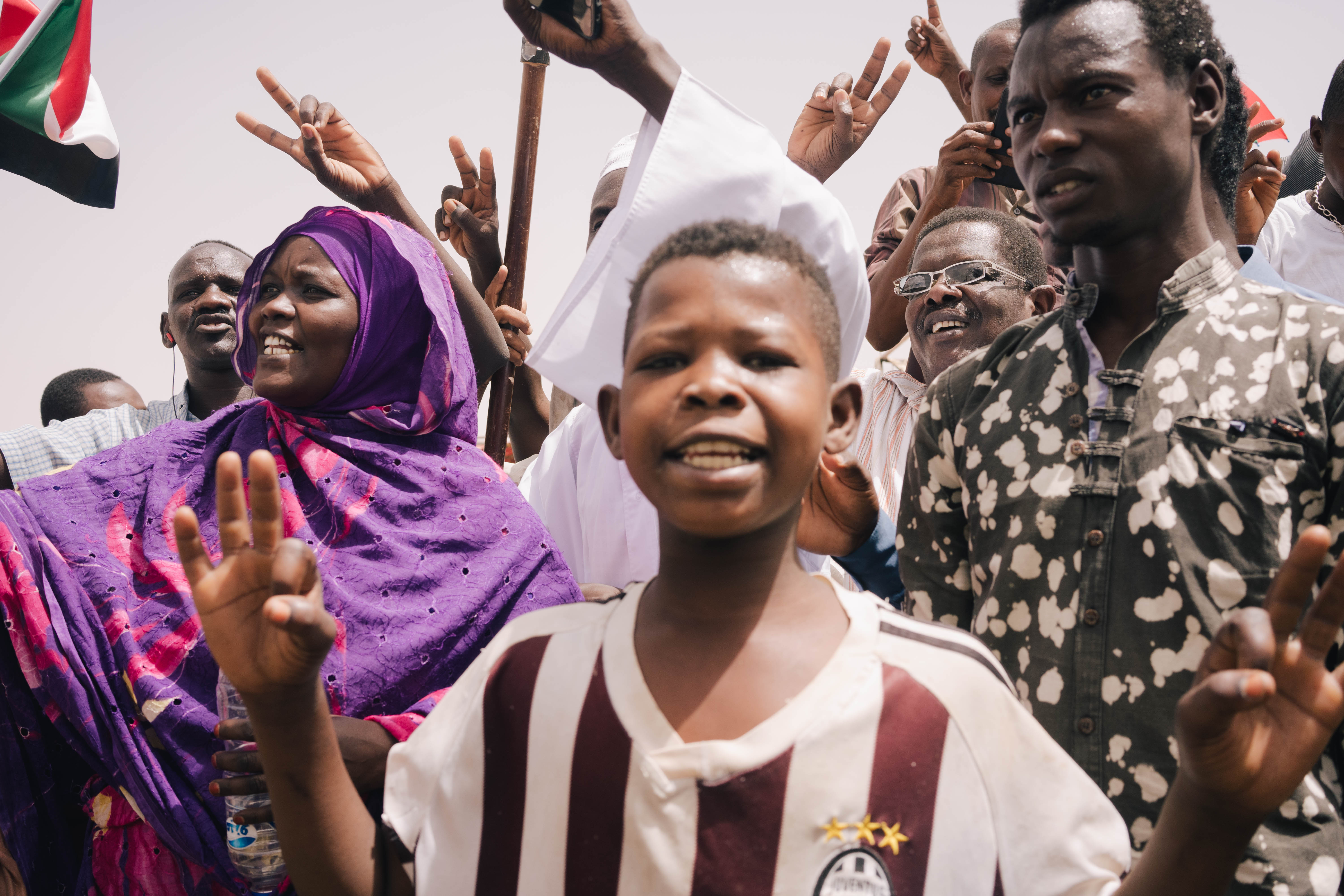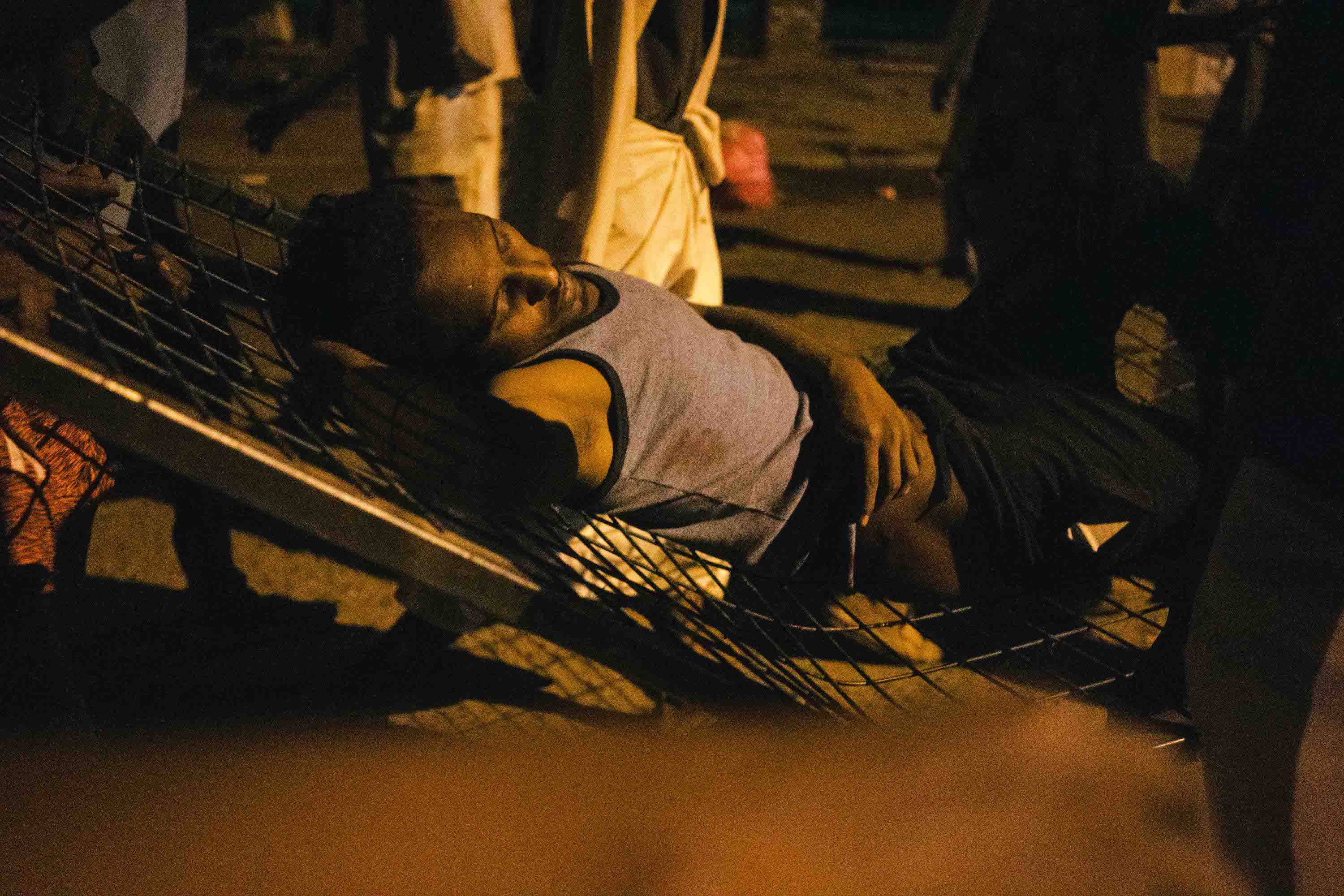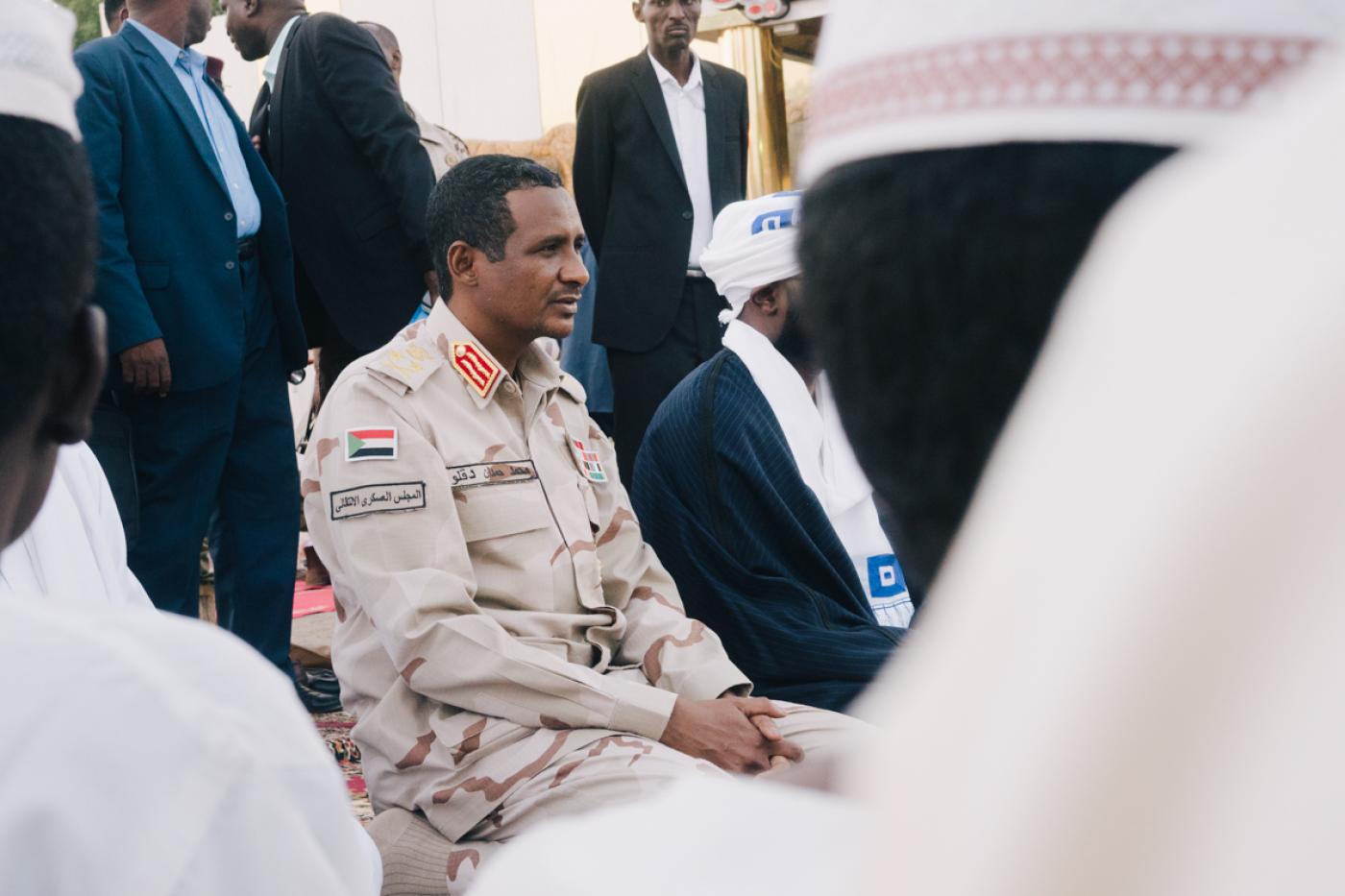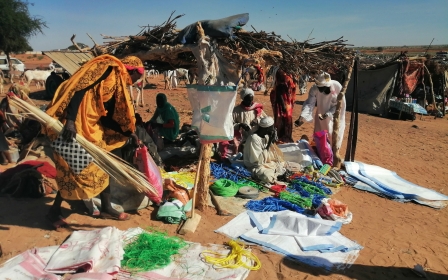The year that changed Sudan began with a matchstick

As charred as the despised building it torched, the matchstick used to light the fire that fuelled a Sudanese uprising is rumoured to still sit in the pocket of the protester who struck it.
It has even travelled the country, from the northern steel city of Atbara to the capital Khartoum, where news of the famed matchstick's presence spread by word of mouth among protesters.
A year ago, on 19 December 2018, the image of the gutted offices of Sudan's ruling party in Atbara spread like wildfire through social media, feeding public anger over the rising cost of living, igniting far deeper grievances against President Omar al-Bashir and his 30-year rule.
Protests spread through that night, and in the days and weeks that followed, until Bashir finally stepped down on 11 April.
The past year has been an historic one for Sudan, long stifled by corruption and sanctions and torn apart by the government's many wars, as many Sudanese hope 2020 will mark a transition towards a civilian government.
New MEE newsletter: Jerusalem Dispatch
Sign up to get the latest insights and analysis on Israel-Palestine, alongside Turkey Unpacked and other MEE newsletters
19 December 2018: The city of steel and fire
In late 2018, austerity was biting. Queues for bread and fuel were long and prices were high. Sudan's economy had been crippled since the loss of oil wealth with South Sudan's independence in 2011 - and the Bashir government's response was budget cut after budget cut stripping away at the country's social safety nets - including key commodity subsidies - while military spending remained high.
By December 2018, as bread prices suddenly tripled, young protesters - mostly school-age students - spontaneously took to the streets. Such outbursts were quickly snuffed out by heavily deployed government security forces.
Then suddenly, things changed. In Atbara, a student protest on 19 December gathered steam. Demonstrators began by burning barricades in the streets, and ended by torching the local headquarters of Bashir's National Congress Party (NCP).
Translation: A video of the burning of the National Congress Party centre in the city of Atbara
"We were patient about everything but there was no bread [in Atbara] when there was bread in Khartoum. There was no fuel when in Khartoum they had it. Atbara was the town struggling the most in Sudan," recalled Ahmed Jamaluddin, a 40-year-old Atbara resident.
"The spark was Atbara. Not just recently, for a long time, since the first revolutions," he said. "Atbara is a revolutionary town."
Atbara was famously rebellious because of its role as the hub of Sudan's train network, where unions of railway workers were the thorn in the sides of military rulers who preceded Bashir.
Those unions had since been decimated and railway jobs, which had sustained families through generations, had become scant.
"The youth of Atbara entered the NCP office and set it alight, and after that followed Gadaref, Dongola, Madani, Sinnar and the rest of the people," Jamaluddin said, listing cities and towns that rose up soon after that fateful day in Atbara.
As protests spread, Sudanese authorities imposed a state of emergency and blocked social media in an attempt to halt the spread of the images from Atbara. But within a week, the nascent movement had reached the capital.
A group called the Sudanese Professionals Association (SPA) emerged, posting on social media last-minute instructions on where to meet in downtown Khartoum to participate in marches towards Bashir's presidential palace, where they hoped to deliver a letter demanding his resignation.
Though it had been built over several years, taking lessons from the violent crushing of the last major protests in 2013, the SPA initially remained a faceless organisation. Nonetheless, it still managed to build momentum.
Its organising tactics made it hard for security forces to identify the SPA's leaders, who were able to give direction to spontaneous protests around the country, even chasing Bashir away when he made official visits.
Localised neighbourhood teams known as resistance committees emerged, taking a grassroots approach to organising that meant the protests did not burn out with the end of 2018 - for months more, they would be a daily event.
6 April 2019: The sit-in
From December through April, the pattern of demonstrations remained largely the same.
Cities around Sudan and neighbourhoods of Khartoum continued to witness protests daily. Security forces responded with tear gas, rubber-coated steel bullets and even live fire. They arrested so many that prisoners told MEE they were often released on the same day because there was no space to keep them all detained.
To shame protesters, police shaved their heads. The killing of protesters would lead to angry funerals - but Bashir was not budging.
Protesters decided that on 6 April, they would march towards the military headquarters to mark the anniversary of the 1985 uprising that overthrew notorious military ruler Gafaar Nimeiri.
But they knew the army would not allow them to reach their headquarters.
The strategy was simple, an extension of the methods they had used for months to stretch security forces out. The demonstrators made public plans for the protest - but the advertised times and rallying points were a distraction, a defected security source told MEE on condition of anonymity.
Secretly, other groups of protesters were assembled earlier in the day in places where police was not expecting them, avoiding detection with the help of sympathisers inside the security forces, who passed on inside information and ensured certain streets were not closed.
When those protesters began their advance on the military headquarters - a usually heavily guarded space at the centre of Khartoum - just as the rest of the popular movement started marching at other points in the city, security forces were too spread out.
Just like that, protesters had successfully captured a sprawling space outside the headquarters.
The successful maneuver imbued the crowds with renewed enthusiasm. Suddenly, the movement had a rallying point in one of the capital's most crucial areas and no one wanted to leave. More and more demonstrators poured in, bringing water and supplies. By 3 pm on 6 April, SPA leaders stood in front of the crowds to announce that the sit-in would not move until Bashir was gone.
Bashir ordered for the sit-in to be cleared. In the early morning the next day, security forces showed up, firing at a crowd of people laying flat on the ground to avoid the bullets.
But some of the army units stationed at the site took the side of the demonstrators, turning from a menacing presence into a protective force that actively clashed with Bashir's forces.
"Some of the security forces said they wouldn't get involved because they said there would be too much death," the defected security source said.
Several attacks by police and intelligence forces over the next two days were repelled by rank-and-file soldiers, frustrating Bashir. Angry, he summoned militias associated with his party to launch another attack on the morning of 8 April.
"They came from three directions. Police and intelligence agencies supported them," the anonymous defector said. "There was an abandoned building, snipers were stationed on top of it and fired at protesters."
Security forces were, however, once again unable to dislodge the protesters, who had by now formed an unofficial pact with the defected soldiers where both parties always stuck close to each other, creating a mass Bashir's forces could not break down.
The protesters built barricades around the protest site, conducting amicable searches to prevent infiltrators smuggling in weapons. They also built a community, setting up tents, bringing in food and supplies and providing emergency healthcare.
When they awoke on 11 April, the sit-in remained and Bashir was gone.
The next few days marked a power struggle inside Bashir's military circle. Ahmed Awad ibn Auf, who announced Bashir's removal and the creation of a military council to replace him, was himself unseated after a day. So was Bashir's intelligence chief Salah Gosh.
Eventually, the leadership settled on General Abdel Fattah al-Burhan to lead the council, with Mohammad Hamdan Dagolo, known more commonly as Hemeti, as his deputy.
Meanwhile, the sit-in continued.
Hemeti, in particular, worried the protesters. He led the Rapid Support Forces (RSF), a government paramilitary group that had emerged from the Janjaweed militias accused of genocide in Darfur, allegedly killing 300,000 people under Bashir's orders.
Hemeti said he turned on Bashir after being ordered to violently clear the protests. But his intentions were questioned, especially as RSF forces suddenly mushroomed across Khartoum, a city they were usually not seen in, occupying street corners where they loitered on pick-up trucks loaded with rocket-propelled grenades and machine guns.
In the days that followed Bashir's ouster, the military council began negotiations with the Forces of Freedom and Change (FFC), an umbrella group that included the SPA. Though breakthroughs were occasionally announced, every time the public stayed up past midnight for an announcement, they were told of more delays.
Though the military spoke of concessions to civilians, it was not going to hand over power. Even as a detailed power-sharing agreement was being drawn, the military insisted it must remain the dominant power.
In the meantime, the military council became more bullish. Hemeti declared it would not accept chaos, leaving the protesters on edge, especially those who manned the barricades around the sit-in.
Then, on 13 May, as protesters awaited one more late-night announcement, they suddenly heard the sound of gunfire.
Men dressed in the uniforms of Hemeti's RSF forces had suddenly begun firing on the crowd, using the heavy machine guns mounted on their trucks to mow down protesters.
Gunfire rattled through the night, coming from several directions around the sit-in, where thousands were camped out.
Protesters formed human corridors leading to health clinics, the dead and injured carried on fencing ripped from the ground and treated on bits of bedding or furniture.
To stop any RSF advance, protesters dug bricks from the pavement and built new barricades, taller than anything that had been seen before. By morning, they had extended the protest area to almost reach the presidential palace.
Talks resumed and the RSF stepped back. The SPA convinced protesters to dismantle the roadblocks and return to the sit-in. But the relationship, already suspicious, had soured.
3 June 2019: The massacre
At their makeshift encampments in buildings and parks that were never intended to serve as military barracks, RSF forces usually spent the nights in eager discussion, drinking tea and telling tales of their missions on Sudan's margins or in Yemen, places far from the capital where they now sat.
But on the night of 2 June, they went to their beds early, aware that a mission awaited them before dawn.
Meanwhile, protesters who, they too, debated deep into the night, gathered around the sit-in's many tea vendors, unaware of what was to come.
The first sign was when the power went out a little after midnight.
In the darkness beyond the sit-in's perimeter, trucks carrying RSF and other armed forces rolled through Khartoum's streets towards the military headquarters, massing just beyond the protest barricades and on the other side of the River Nile.
By 5 am on 3 June, bullets were crackling through the air. A mass of troops, most in RSF uniforms, stormed the sit-in area from the north, tearing through the protest area.
Protesters who faced their bullets were gunned down. Others were rounded up. Tents were burned and an untold number of bodies were thrown into the Nile. The massacre many had feared on 13 May was now underway.
Many of the soldiers filmed themselves as they marched through the sit-in area, beating protesters with canes and demanding they chant in favour of the military.
Within a few hours, there was nothing left of the sit-in that had lasted almost two months.
In the hours that followed, the RSF took over all Khartoum, dismantling barricades, scaring the city's population into their homes and seemingly breaking the back of the protest.
At least 120 people were killed that day.
30 June 2019: The strike and the deal
But the muzzle enforced on the protesters did not contain them for long. Within days, protests were starting again.
Instead of trying to return to the sit-in, protesters decided to renew their neighbourhood-based activities, building barricades that would frustrate security forces, only to quickly run away. They were gaining momentum again.
The FFC called for civil disobedience and a general strike that disturbed the stability the military council was keen to impose. It called for a "march of a million" on 30 June. That march, it turned out, would surprise many with its strength, with tens of thousands coming out in Khartoum and mass protests all around the country. The military council again used a show of force, killing at least seven protesters.
The FFC, it seemed, still had the power to negotiate with the military despite the crushing blow of the 3 June massacre.
Within a few days, it declared an end to the civil disobedience that many viewed as pushing the military into the corner, and announced that progress had been made towards a power-sharing deal. An agreement was signed on 17 July and Prime Minister Abdalla Hamdok was appointed a few weeks later.
August 2019: A transitional government
A former UN economist, Hamdok was appointed to deal with one of Sudan's most pressing problems. He drew up a civilian cabinet that was largely welcomed, and set about becoming the international face of the transitional government.
In September, Hamdok attended the UN General Assembly in New York City, making repeated appeals for Sudan to be removed from the US list of state sponsors of terrorism - a move which would allow the country to finally receive economic aid after decades of sanctions under Bashir.
But the arrangement between civilian leaders and the military is still viewed with suspicion by many, even those who want to give it the benefit of the doubt.
A body known as the Sovereign Council operates alongside the cabinet, split evenly between military and civilian members but led by the generals for the next two years. Burhan remains its chair and Hemeti continues to unofficially operate as his deputy, using the title despite the role not existing.
The two have continued to lead relations with Saudi Arabia, which has provided emergency funds to Sudan to support its economy, maintaining the relation built when Sudanese fighters were sent to Yemen to fight for the Saudi-led coalition.
Hemeti's RSF has been building its own support base by carrying out social work around the country. They provide transport, build schools and dole out food supplies, filling some of the gaps that the state still has not been able to fill.
But protests continue.
Though Khartoum has been quiet, Sudan's margins have been active, even in the face of violence. Protests in Darfur have been regular. In South Kordofan, a month-long sit-in demonstrated against the use of cyanide in gold-mining operations allegedly run by Hemeti. When RSF troops finally abandoned the site, they allegedly dumped the dangerous chemicals in a river.
Some can hardly tell the difference. Some residents of a Darfuri displacement camp, created by Bashir's wars in the 2000s, said they were not even aware he was gone.
A young Darfuri student living in Khartoum told MEE he still does not trust the military leaders.
"I'm with the revolution, but I do not know if this will help us," he said.
For now, he will wait and see. But if progress remains delayed, he plans to join the flow of Sudanese aiming for Europe, risking the passage through war-torn Libya and the waves of the Mediterranean Sea.
This article is available in French on Middle East Eye French edition.
Middle East Eye delivers independent and unrivalled coverage and analysis of the Middle East, North Africa and beyond. To learn more about republishing this content and the associated fees, please fill out this form. More about MEE can be found here.


